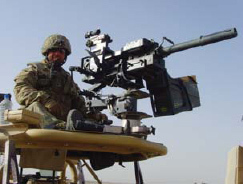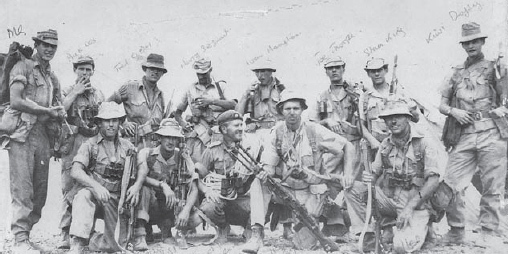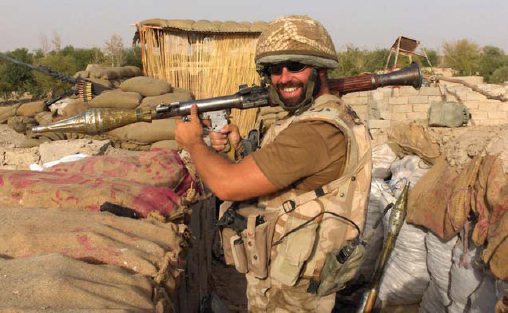
Heckler & Koch 40mm Grenade Machine Gun mounted on a Jackal pictured in Afghanistan in 2010. (Photo courtesy Tom Blakey)

Some things never change – a piece of kit as familiar to an old-timer like me as it is to you today – a GPMG takes pride of place in this photograph. This particular GPMG was used in a sustained fire role in Radfan, Yemen, 1964. (Photo courtesy Colour Sergeant Trevor ‘Sadie’ Sadler, 1st Battalion ‘The Vikings’ Royal Anglian Regiment)
The problem is that this gun needs an electric power supply and weighs 66lb without its mount or ammunition. You don’t want to carry one very far. And the recoil is 300lb of pressure against the direction of fire so don’t believe anyone fires one of these from the hip either. For all the above reasons the mini gun has been mounted on helicopters, other aircraft and riverboats since Vietnam times.
More recently a firm called Dillon has begun manufacturing an improved version of the basic design, known as the M134D. This has many upgrades in detail, resulting in decreased weight of the system (especially when using a titanium gun body), improved reliability and better handling and maintenance.
I have mentioned it here because they are beginning to be used on light armoured vehicles as their high rate of fire makes them a comfort in an ambush situation. I think the enemy may find them a little off-putting as well.
Heckler & Koch 40mm Grenade Machine Gun (GMG)
Effectively this is a machine gun which fires explosive shells. The shells will penetrate 2in of armour or any sort of wall and the detonation will kill anyone within about 5 yards and wound out to 15 yards.
The GMG or Granatmaschinengewehr as the Krauts call it, was developed by the fine German engineers at Heckler & Koch for the German Army in about 1992. It has been adopted by British and other European forces because it is truly excellent. There is a very similar weapon built in the US called the M19. The only significant difference is that the GMG can be set up to feed from either side and this would allow it to be mounted in a twin side-by-side situation.
Operation is blowback and rate of fire is 350 rounds per minute cyclic but this cannot be maintained in the field owing to the difficulty of feeding such a bulk of ammunition. A realistic rate of fire allowing for switching boxes and joining belts is around 40 to 60 rounds per minute.
The extreme range is about 2,200m but it is usefully accurate out to about 1,500. You can get all sorts of clever night sights to fit it too. In a word – excellent.
The weapon itself weighs about 64lb and the stand another 22lb. The ammo weighs a ton so obviously it is a vehicle mount by choice but you can dismount one to set it up on a perimeter. The recoil is not excessive, surprisingly, so the little tripod just digs into the ground nicely and gives a good firing platform.
Summary: What are the important things to remember about machine guns?
Don’t carry a machine gun on a foot patrol without considering the situation as the automatic rifle is often sufficient for firepower. Do try to obtain a machine gun when you are in a static position or have vehicles as then the advantage is free of the weight cost. A 7.62mm gun is plenty for use against infantry but a 12.7mm is very good for demolishing a building sheltering insurgents. Try not to get lumbered with carrying the gun. The GMG is also superb for taking out enemy sheltering in buildings.
ROCKET LAUNCHERS
‘Rocket Launcher’ is the popular name for a range of hand-held anti-tank weapons. Technically, these are all ‘Recoilless rifles’ as the propellant charge is ignited and burns completely in a tube or barrel open at both ends rather than in a rocket motor carried by the projectile. Nevertheless, rocket launcher is what they are popularly called.
Goal: When is the right time to employ this weapon? What can it do?
There are a few hand-held rocket launchers around but only one is used by insurgents and this is called the RPG – short for rocket propelled grenade. The RGP7 is common and the newer RPG29 models are around here and there. It will penetrate 10.6in of steel armour up to a range of 1,100m and then self-destruct by a time fuse.
Hand-held rocket launchers aren’t used much against tanks. It is, of course, what they were originally designed for but insurgents don’t have many tanks for you to shoot at and ours are pretty much resistant to hand-held rocket launchers because of clever armour.
Soft-skinned and lightly armoured vehicles have no defence against the RPG7 so they are often used to open up an ambush by stopping the lead vehicle – so to speak. On the good side, the blast may pass through the vehicle without harming many people as light armour is easily penetrated. However, when armour forms a box it can have the effect of compressing the shock wave inside the crew compartment with unfortunate effects on the crew members. The answer to this is a type of spaced armour grill mounted on the outside of the armour which causes the rocket to detonate too far away from the main armour skin to penetrate it.

Tom models the RPG7, Afghanistan 2010. (Photo courtesy Tom Blakey)
There was a certain American officer of my acquaintance whose idea of tactics was to drive his soft skinned command vehicle – a Mercedes Unimog truck – into an enemy base and everyone fired outwards... I’m not saying he didn’t have lots of guts but perhaps that was more courage than sense. Anyway, one day he did this and the opposition fired an RPG7 at the truck. The projectile hit the low tin-plate side which set off the shaped charge. The blast came forward through the side and cut off the leg of the young man operating the radio. It took off the leg close to the hip without doing any other damage – funny how these things happen – and the flash of the blast cauterized and sealed the wound. The young soldier – 18 I think he was – became an instructor and a walking warning as to the danger of RPG7s. (Best regards if you read this, buddy.) Interestingly enough, he was assigned to teach armoured warfare to potential targets of the RPG7. Strange how the military mind works...
Helicopters are a favourite target for the RPG7 where heavy machine guns can’t be moved to the attack site and shoulder-launched anti-aircraft missiles are in short supply. Choppers take a lot of knocking down so the RPG7 is ideal if the attacker can actually hit the aircraft. The tactic often employed is to have a whole group of people fire at the same chopper from ahead or astern and hope for a hit.
Because of their light weight and knockdown punch rocket launchers are used mostly where an explosive charge needs to be fired by an infantryman. For a Special Forces operator it could be used for destroying vehicles, a house or a bunker or it could be aircraft on the ground or helicopters at very short range.
History: How did it develop to be the way it is?
During World War I the need arose for anti-tank weapons, but grenades and mines were the only types in common use, aside from field artillery fired over open sights of course.
Between the wars and into World War II several types of light anti-tank weapon appeared. The British began with a grenade launched from a rifle and this developed into a special weapon called a PIAT (Projector, Infantry, Anti Tank), which used a spring, amazingly, to launch a type of grenade at the target. This was the first use of what is called the HEAT (High Explosive Anti Tank) principle where a charge flattens against armour and on detonation either pushes through it or sends a shock wave through it to break off a ‘scab’ on the inside. The semi molten scab then flies around inside the tank with obvious results...